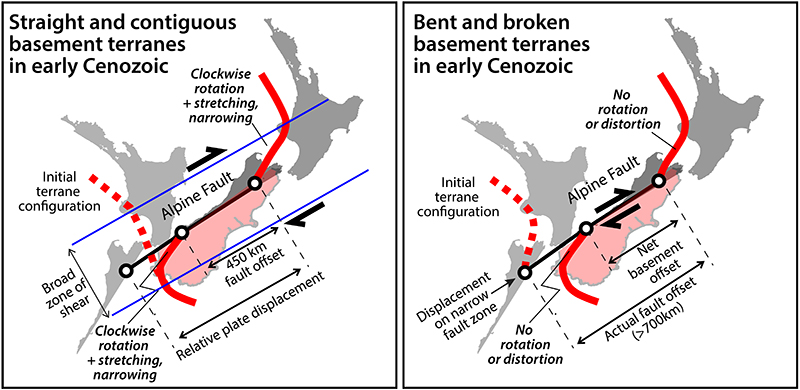Source: Geochemistry, Geophysics, Geosystems
In New Zealand, the boundary between the Pacific and Australian plates is defined by the Alpine Fault, a major strike-slip feature with a small horizontal component of compression that is actively raising the Southern Alps mountain range along the South Island’s western edge. According to the prevailing view, the Alpine Fault has accommodated about 450 kilometers of right-lateral displacement during the past 40 million years.
Because this offset accounts for less than 60% of the long-term relative motion between these plates, previous studies have assumed that rotation and displacement on other faults across a 300-kilometer-wide zone have accommodated the difference. However, Lamb et al. question this view and present an alternative view of long-term deformation in this area.
On the basis of a reinterpretation of structural and paleomagnetic data, the team suggests that previous displacement estimates rely on incorrect assumptions about the orientation of a series of terranes that are offset along the Alpine Fault. Earlier studies assumed that these terranes were contiguous across the fault in the Eocene, when the modern plate boundary developed. The authors conducted a reanalysis of paleomagnetic data from the sediments covering these terranes, ranging from 36 million to 15 million years in age, and found that there was insufficient deformation during that period to account for their present locations.
The results instead suggest that the total displacement along the Alpine Fault has exceeded 700 kilometers in the last 25 million years. This offset, the researchers argue, has reversed roughly 225 kilometers of left-lateral motion that occurred during the Late Cretaceous. This early left-lateral displacement was linked to rifting between East and West Antarctica during the breakup of Gondwana.

To accomplish this hefty displacement, the Alpine Fault has maintained an average rate of slip comparable to its present-day rate (about 30 millimeters per year) over the last 25 million years—a rate that is both faster and longer-lived than those of other major continental strike-slip boundaries.
The revised history indicates that a narrow, 10-kilometer-wide zone straddling the fault has accommodated more than 94% of the relative plate motion, suggesting that deformation at continental plate boundaries does not need to occur across broad distributed zones, as has been widely assumed. Instead, they more closely resemble oceanic plate boundaries, where relative plate motion is accommodated by narrow transform faults with lengthy histories spanning tens of millions to hundreds of millions of years. (Geochemistry, Geophysics, Geosystems, doi:10.1002/2015GC006225, 2016)
—Terri Cook, Freelance Writer
Citation:
Cook, T. (2016), Revising the displacement history of New Zealand’s alpine fault, Eos, 97, https://doi.org/10.1029/2016EO056289. Published on 22 July 2016.
Text © 2016. The authors. CC BY-NC-ND 3.0
Except where otherwise noted, images are subject to copyright. Any reuse without express permission from the copyright owner is prohibited.

